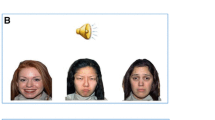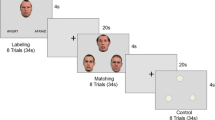Abstract
Recognition of facial expressions and vocal prosody was examined using the Diagnostic Assessment of Nonverbal Accuracy 2 (DANVA-2) and the Carolina Older Adult Test of Nonverbal Communication (COAT-NC) for 24 individuals with traumatic brain injury (TBI) and 24 matched controls. Results demonstrated that participants without TBI scored significantly higher than participants with TBI when presented with adult photo and voice stimuli. No significant group difference was noted with child photo and voice stimuli. Both groups scored significantly higher on photo subtests than on voice subtests for child and younger adult stimuli. For older adult stimuli, both groups scored significantly higher on the voice subtest than on the photo subtest. For the subjects with TBI, a significant relationship was found between scores on the voice subtests and a functional measure of cognition and communication.
Similar content being viewed by others
References
Benowitz, L.I., Bear, D.M., Rosenthal, R., Mesulam, M.M., Zaidel, E., & Sperry, R.W. (1983). Hemispheric specialization in nonverbal communication. Cortex, 19, 5–11.
Blonder, L.X., Bowers, D. & Heilman, K.M. (1991). The role of the right hemisphere in emotional communication. Brain, 114, 1115–1127.
Bowers, D., Blonder, L.X., Feinberg, T., & Heilman, K.M. (1991). Differential impact of right and left hemisphere lesions on facial emotion and object imagery. Brain, 114, 2593–2609.
DeKotsky, S.T., Heilman, K.M., Bowers, D., & Valenstein, E. (1980). Recognition and discrimination of emotional faces and pictures. Brain and Language, 9, 206–214.
Dixon, W.J. (1988). BMDP statistical software manual. Berkeley, CA: University of California Press.
Feldman, R.S., Philippot, P., & Custrini, R.J. (1991). Social competence and nonverbal behavior. In R.S. Feldman & B. Rime (Eds.), Fundamentals of nonverbal behavior (pp. 329-350). Cambridge: Cambridge University Press.
Frattali, C.M., Thompson, C.K., Holland, A.L., Wohl, C.B., & Ferketic, M.M. (1995). Functional Assessment of Communication Skills for Adults: ASHA-FACS. Rockville, MD: American Speech-Language-Hearing Association.
Hagan, C., Malkmus, D., & Durham, P. (1979). Levels of cognitive functioning. In Rehabilitation of the Head Injured Adult: Comprehensive Physical Management. Downey, CA: Professional Staff Association of Rancho Los Amigos Hospital.
Helm-Estabrooks, N. & Hotz, G. (1990). Brief Test of Head Injury. Chicago: Riverside.
Jackson, H.F. & Moffat, N.J. (1987). Impaired emotional recognition following severe head injury. Cortex, 23, 293–300.
Jennett, B. & Bond, M. (1974). Assessment of a coma: A practical scale. Lancet, 1, 81–84.
Kertesz, A. (1982). Western Aphasia Battery. New York: Grune & Stratton.
Kowner, R. (1996). Facial asymmetry and attractiveness judgment in developmental perspective. Journal of Experimental Psychology: Human Perception and Performance, 22(3), 662–675.
Lalande, S., Braun, C.M.J., Charlebois, N. & Whitaker, H.A. (1992). Effects of right and left hemisphere cerebrovascular lesions on discrimination of prosodic and semantic aspects of affect in sentences. Brain and Language, 42, 165–186.
Lehiste, I. (1970). Suprasegmentals. Cambridge, MA: MIT Press.
McCutcheon, E.P. & Selassie, A.W. (1992). Summary of traumatic head injury and traumatic spinal cord injury data for S.C. and the U.S. The Head & Spinal Cord Injury Task Force Report. South Carolina Developmental Disabilities Council.
Meredith, W.M. (1967). Basic mathematical and statistical tables for psychology and education. New York. McGraw-Hill, Inc.
Nowicki, S. & Carton, J. (1993). The measurement of emotional intensity from facial expressions. Journal of Social Psychology, 133 (5), 749–750.
Nowicki, S. & Duke, M.P. (1994). Individual differences in the nonverbal communication of affect: The diagnostic analysis of nonverbal accuracy. Journal of Nonverbal Behavior, 18(1), 9–35.
Pazgan, A. & Wooddy, H. (1996). Gender differences in the nonverbal communication of Affect. Unpublished master's thesis, University of South Carolina, Columbia.
Prigatano, G.P. & Pribram, K.H. (1982). Perception and memory of facial affect following brain injury. Perceptual and Motor Skills, 54, 859–869.
Shaver, M. (1996). Age differences in the nonverbal communication of affect. Unpublished master's thesis, University of South Carolina, Columbia.
Sohlberg, M.M. & Mateer, C.A. (1989). Introduction to cognitive rehabilitation: Theory and Practice. New York: Guilford Press.
State University of New York at Buffalo Research Foundation (1993). Guide for use of the Uniform Data Set for Medical Rehabilitation: Functional Independence Measure. Buffalo: Author.
Thomsen, I.V. (1984). Late outcome of very severe blunt head trauma: A 10-15 year second follow-up. Journal of Neurology, Neurosurgery, and Psychiatry, 47, 260–268.
Weathers, M. (1996). Race differences in the nonverbal communication of affect. Unpublished master's thesis, University of South Carolina, Columbia.
Ylvisaker, M. & Gobble, E.M.R. (Eds.). (1987). Community re-entry for head injured adults. Boston: College Hill Press.
Author information
Authors and Affiliations
Rights and permissions
About this article
Cite this article
Spell, L.A., Frank, E. Recognition of Nonverbal Communication of Affect Following Traumatic Brain Injury. Journal of Nonverbal Behavior 24, 285–300 (2000). https://doi.org/10.1023/A:1006675230193
Issue Date:
DOI: https://doi.org/10.1023/A:1006675230193




